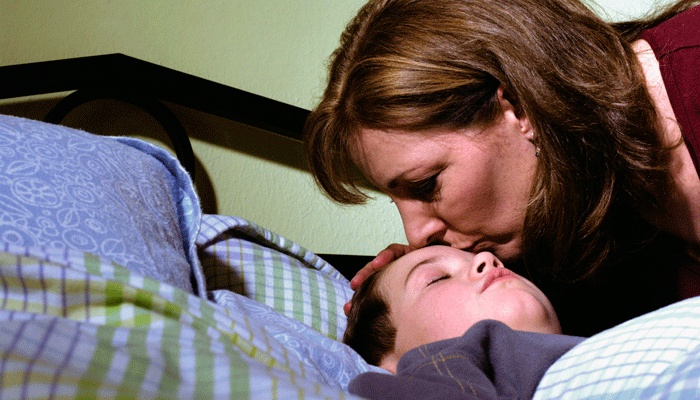When we, as new parents or parents-to-be, think about our children sleeping, we all dream of a happy, peaceful child sleeping soundly while we’re in the other room getting a full night’s rest ourselves. This is rarely the reality, however—at least at the beginning of parenthood. How do we make that dream a reality?
Newborns: Parents Need to Be in Survival Mode
Newborns may sleep as much as 22 hours of a 24-hour day—but not for long stretches. They don’t have any notion of day or night, so they wake up to eat and get their diaper changed every one to three hours, around the clock. I always tell new parents that they need to think of themselves as being in “survival mode.” Sleep when the baby sleeps. This is easy enough with your first child, but much harder if you have older children who also need your attention. Recognize that you’re not going to accomplish much else, because you’ll only have those one- to three-hour sleep stretches.
Safe sleep setups: As adoptive parents, we may have been waiting a long time for our kids, and there’s nothing nicer than a sleepy baby in your arms. But when you’re planning to go to sleep yourself or when you are so exhausted that you might fall asleep, it’s important that you put your baby on his back in a safe place to sleep—a firm, flat surface with no blankets or fluffy toys. This can be in a crib, a bassinet, or a sidecar co-sleeper that parks next to your bed. Co-sleeping with a newborn in your bed is not safe.
Adjust the environment and feel free to use props: Short of sleeping in the same bed, do what you can to settle your baby and get some sleep yourself: dim the lights, play soft music. Babies are often soothed by background noise. There are CDs and apps with sounds like ocean waves or rainfall, or many parents just run the clothes dryer or the vacuum cleaner. Swaddling a baby helps reduce his startle reflex; a pacifier can help because many babies are soothed by sucking on things.
“Wear” your baby during the day: When you’re awake, a Moby wrap, Ergo, or another safe carrier will let you move around while keeping baby close—hearing your heart, feeling the rhythm of your breathing.
Encourage self-soothing as your baby grows: Between four and six months of age, most babies can start to self-soothe and sleep for longer stretches at a time—up to six hours, and then eventually 10 to 12. This is a beautiful thing for parents. Instead of feeding your baby until he’s sound asleep and then very gingerly putting him down, you can start to put the baby into his crib when he’s drowsy but not all the way asleep. The baby begins to learn that he can fall asleep on his own, whether at bedtime or after waking up at 2 a.m.
If your baby has been with you since infancy and is securely attached, it’s OK to start pushing her to sleep for longer periods around six months of age. Stick to a consistent routine, and stop picking up and feeding the baby during the night. This sends the message, “It’s bedtime. You’ve been fed. You have a clean diaper. You’re warm. We’ve had our stories. We had our kisses. Goodnight. I’ll see you in the morning.” Richard Ferber, M.D., pioneered this method called “cry it out.” This sounds harsh, but babies in that six-to-12-month range usually get the idea within a few days.
Older Children: Parents Need to Make Bedtime Warm and Cozy
When children join their families beyond infancy, their histories matter. A child may have experienced being cold, being hungry. She may have witnessed or been the victim of abuse or violence, and the primary emotion she associates with nighttime is fear. She may be used to sleeping in a ward with 30 other children and has never been alone in a dark room before. Even if a child’s prior circumstances were not that horrendous, she is still moving to a new and unfamiliar world, so it’s going to be hard to sleep for a while.
Don’t let older kids cry it out: A parent’s first and most important goal is to teach the child that he is safe and you are here when he needs you. This is absolutely not the time to use cry it out strategies. This child already knows all about being alone and crying and having nobody come. What you need to stress to this child is, “I will make bedtime warm and cozy and safe for you. No matter what, I [or we] will be here when you need me.”
Work toward your long-term goals: Think about where you want your child to sleep and how you eventually want bedtime to look. If you don’t want your child in your room or your bed forever, don’t start there. Because there aren’t safety issues with co-sleeping with an older child, many parents think, “Oh, we’ll have her in our bed for awhile, just for bonding.” Years later, that child still wants to be in your bed. So if you’d like your child to sleep in her room, start there.
Gradually wean yourself from the routine: I always advise parents with children new to them to be “as physically and emotionally present as your child needs you to be, and then gradually wean yourself out as quickly as he’ll let you.”
Your child might need your physical presence as reassurance at first, so you could move a spare bed or place a mattress on the floor in the child’s room. When your child wakes, reassure him, “It’s OK. You’re safe. I’m here.” The mattress might start right next to the child’s bed, but, as he begins to count on you for safety and comfort, you can move it a few inches away, a few feet, across the room, then eventually just outside the door.
Don’t listen to the skeptics: I can promise you that you will have people offering all kinds of advice and saying, “You’re crazy. You’re spoiling this child. I just let my child cry it out and after three days she was fine.” You may have to do some education of family and friends. You can reply with something like, “Because of this child’s history and early circumstances, her needs are different and this is working for us. We hope you can respect that and support us.”



